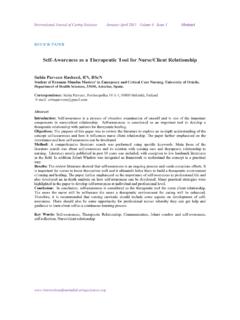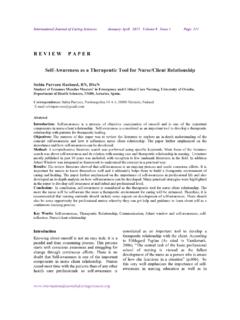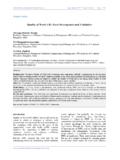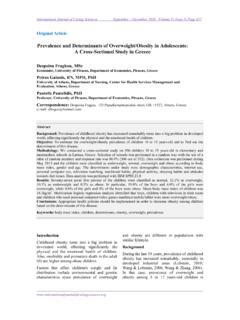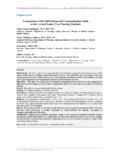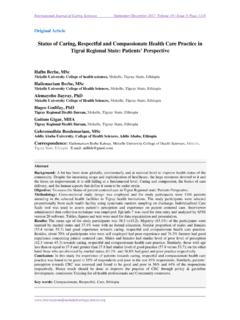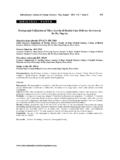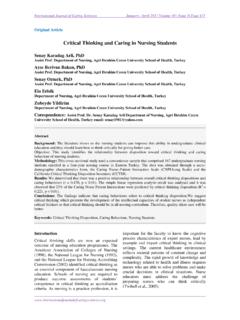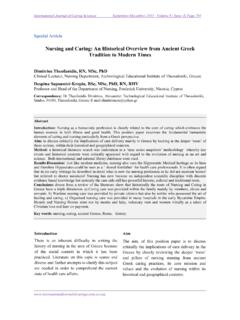Transcription of 6. Burnell Compassionate Care Tool
1 International Journal of Caring Sciences 2013 May August Vol 6 Issue 2 180.. ORIGINAL PAPER .r . Compassionate care : Can it be Defined and Measured? The Development of the Compassionate care Assessment tool Lori Burnell , PhD(c), RN, NEA-BC. Vice President, Chief Nursing Executive & Chief Operating Officer, Scripps Mercy Hospital San Diego, CA, USA. Donna L. Agan, EdD. Director, Operations Integration, Scripps Mercy Hospital, San Diego, CA, USA. Correspondence: Lori Burnell , Scripps Mercy Hospital, 4077 Fifth Avenue, MER-1, San Diego, CA 92103, (office) 619-260-7377, (fax) 619-686-3530 E-mail: Abstract Background: Compassion has not been universally defined or understood, nonetheless is recognized as a component of nursing excellence. If Compassionate care is routine in health care delivery models, nursing behaviors and actions that exemplify compassion ought to be easily identifiable to patients. However, a standardized scale measuring Compassionate care attributes has been notably absent.
2 Objective: To address this gap and ascertain the importance of Compassionate care to patients, a Compassionate care Assessment tool (CCAT) was formulated. This new tool , derived from a pilot study of two published surveys, combined the constructs of compassion and caring to generate 28 elements of Compassionate care . Methodology: The CCAT was administered to 250 hospitalized patients. Patients were asked to rate (a) the importance of these items to Compassionate care and (b) the extent to which nurses made this type of care apparent to them. Results: Four categorical segments illustrated compassion from the patients' perspective: the ability to establish meaningful connections, meet expectations, exhibit caring attributes, and function as a capable practitioner. Conclusions: The provision of Compassionate care requires a holistic approach. Patients value nurses forming personal connections, serving as their advocates, and responding to their individual needs.
3 Key words: Compassionate care , spirituality, patient satisfaction, patient centered care , health care surveys, communication, nurse-patient relations Introduction and Background connection with a patient abounds in the literature (Buck, 2006; Grant, 2004; O'Brien, 2008; Schultz Compassionate care , according to Roach (2007), et al., 2007). Furthermore, discourse on requires immersion into the pain, brokenness, fear, compassion asserts it is critical to establishing and anguish of another, even when that person is a meaningful nurse-patient relationships (Davis, stranger. Professional standards call for nurses to 2006; Roach, 2007; Wallis, 2005). Provision 1 in practice with compassion ( , American Nurses the ANA (2001) Code of Ethics expresses Association [ANA] Code of Ethics, International nursing's commitment to patients and the Council of Nurses), and innumerable hospital community, stating The nurse, in all professional mission and vision statements include compassion relationships, practices with compassion and as an essential purpose and directive (American respect for the inherent dignity, worth, and Nurses Association, 2001; International Council of uniqueness of every individual, unrestricted by Nurses, 2006, Milton, 2003).
4 Discussion of considerations of social or economic status, compassion as a means of establishing a International Journal of Caring Sciences 2013 May August Vol 6 Issue 2 181. personal attributes, or the nature of health These two surveys offered a potential connection problems (p. 7). between the patient's need for compassion, found Compassion has been defined as a sympathetic only in the Spiritual Needs Survey, and the nurse's consciousness of others' distress with a desire to caring responses. The Caring Behaviors Inventory alleviate it (Merriam-Webster, 2010). was selected from the plethora of instruments Furthermore, WordNet (2010) defined caring, an designed to assess and measure caring in nursing adjective related to compassion, as feeling and because it specifically targeted nurse's caring exhibiting concern and empathy for others . Major behaviors as evaluated by patients. world religions have declared compassion as Spiritual Needs Survey fundamental to their beliefs and customs (Engineer, ; Federman, 2002; Gordon, 1998; The Spiritual Needs Survey addressed seven major Kohler & Hirsch, 2002).
5 Accordingly, compassion constructs: (a) love and belonging, including in the spiritual context broadened the literature compassion; (b) the Divine; (c) positivity and search leading to the discovery of a tool designed hope; (d) meaning and purpose; (e) morality and to measure patient's needs inclusive of compassion ethics; (f) appreciation of beauty; and (g). (Galek et al., 2005). resolution before death. Galek et al. (2005). developed these constructs through thematic Research Hypothesis analysis of empirical and theoretical models The purpose of this study was to explore measures exploring patients' spiritual needs as found in the of Compassionate nursing care and develop a literature. The survey was designed to ask patients survey tool evaluating the elements of that care in if, during the present hospitalization, they an acute hospital setting. Therefore, the research experienced a need in any of 28 areas. If so, they hypothesis is that attributes of a nurse's delivery of were then asked to rate the degree of importance Compassionate care in a hospital setting can be for that need from slightly to extremely important.
6 Identified, observed, and measured. Items encompassing the construct of love and belonging (compassion) represented the largest Objective - Pilot Study category of patient need (Flannelly, Galek, &. No single, standardized scale for measuring either Flannelly, 2006), including the need for compassion or Compassionate care was found in companionship, kindness/compassion, acceptance, the nursing or health care literature. In an attempt and to love or be loved. The process of developing to bridge this gap, the primary researcher and refining this tool was deemed too long for formulated a quantitative valuation of testing with patients; therefore, 683 pastors and Compassionate care by combining elements from chaplains were consulted, serving as proxies until two published survey tools. A pilot study the final, shorter version was constructed. To date, attempted to ascertain the dialectical relationship the Spiritual Needs Assessment Scale has not been between the spiritual needs of patients, including used to survey patients in any published studies.
7 Compassion, and the caring behaviors of their This was the only tool found that specifically nurses utilizing these two published tools. evaluated the importance of compassion to Methodology Pilot Study hospitalized patients. Caring Behaviors Inventory (CBI). The pilot study was conducted with hospitalized patients (n = 110) at a faith-based hospital in the According to Wu et al. (2006), caring is the core southwestern United States. The study instruments of nursing because of its benefits to both nurses included: and patients (p. 18). In 2000, Wu et al. The Spiritual Needs Survey (Galek et al., administered a 42-item Caring Behaviors 2005), a quantitative instrument designed to assess Inventory (CBI), originally developed by Wolf et spiritual needs, inclusive of compassion, and; al. (1994), to 362 hospitalized patients and 90. The Caring Behaviors Inventory (Wu, registered nurses (RNs) from medical, surgical, Larrabee & Putman, 2006), another quantitative and intensive care step-down units at one West tool that asked patients to rate specific caring Virginia academic health center.
8 In 2004, a behaviors exhibited by their nurses. shortened version (CBI-24) was administered at International Journal of Caring Sciences 2013 May August Vol 6 Issue 2 182. the same hospital and demonstrated high test-retest derived from these elements were captured and reliability (r =. 88 for patients). This survey asked reworded to correspond with the intent of the patients to rate the degree to which nurses made CCAT , designed to be a comprehensive caring apparent to them using a six-point Likert- representation of Compassionate care . The type scale from never to always (Wu et al., 2006). resulting CCAT asked patients to rate the Items included showing concern, meeting patient importance of each item to the term, needs, demonstrating confidence, quickly Compassionate care , from their own perspective. responding to patient calls, and helping with pain Responses were made on a four-point scale from reduction. not important at all to extremely important.
9 Compassionate care Assessment tool Validity. This study was designed to test the (CCAT) validity of the newly developed CCAT . Content validity was established through consultation with The overarching purpose for the development of the three members of the hospital's recognition the CCAT was to identify factors inherent in the committee responsible for selecting the DAISY . provision of Compassionate care in order to Award for Extraordinary Nurses (DAISY. measure the concept and promote its Foundation, 2010), an honor utilizing national implementation in patient care . Patient responses criteria including Compassionate care . Twenty-five to the two survey instruments used in the pilot direct care nurses and five patients also evaluated study helped to identify Compassionate care factors the tool 's ability to measure Compassionate care , included in the CCAT . For example, one thereby establishing face validity. statement on the Spiritual Needs Assessment Survey addressed the patient's need for Objective CCAT Study compassion and kindness and one CBI-24 question A second study endeavored to test the new patient asked patients to rate the frequency of their nurses'.
10 Assessment tool measuring the construct of showing concern for them, which is the definition Compassionate nursing care in a hospital setting. of caring. The patient's need for compassion combined with the nurse's ability to show concern Methodology CCAT Study was used to define Compassionate care . Therefore, The steps needed to complete this research every item on the Spiritual Needs Assessment and included (a) administering the CCAT to an CBI-24 was presumed to relate to Compassionate adequate sample of hospitalized patients, (b). care and the responses to all survey questions were identifying any differences in the rating of statistically analyzed in relation to the compassion Compassionate care elements based on and kindness and showing concern responses. demographic variables, and (c) performing a factor Using the 110 responses in the pilot study, the 10 analysis to organize and classify the components of highest scoring items from each survey were Compassionate nursing care in hospitalized selected, totaling 20 items.
